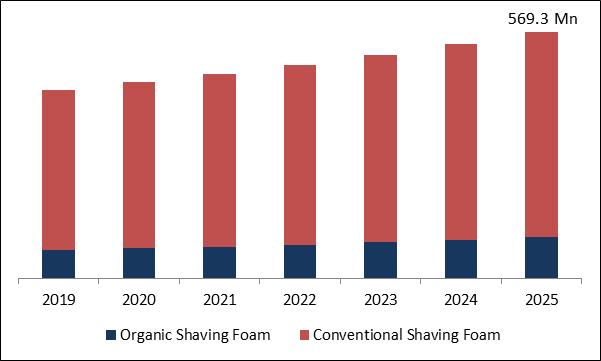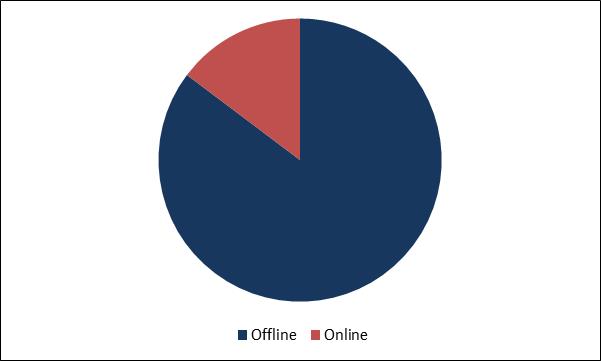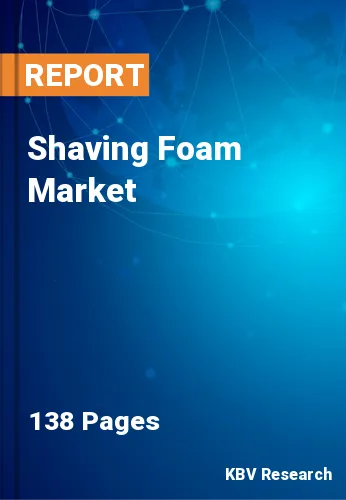The Global Shaving Foam Market size is expected to reach $569.3 Million by 2025, rising at a market growth of 4.6% CAGR during the forecast period. Customers from developing economies of China and India are witnessing an increase in their spending power, which is another prominent factor that can dramatically influence the demand and purchase of personal care products like shaving foam. Brands like Nivea and Gillette have actively penetrated the Asia Pacific market and are expected to drive the shaving foam market. Furthermore, the demand for organic shaving products is on the rise majorly due to the low and rare side effects. Manufacturers focus on developing and innovating to manufacture skin and environment-friendly shaving foam products.
Global Shaving Foam Market Size

Shaving foam is created with a large amount of air that gives it a fluffy texture with a nice lather. Shaving cream or shaving foam is a foamy cosmetic cream that is applied to body hair, mostly facial hair, during the shaving process. Shaving foam helps to lubricate the cutting process, swell keratin, and desensitize the skin. The foam consists of an emulsion of soaps or surfactants, oils, and water. The basic shaving formulations are packed under pressure with a propellant (like iso-butane), to give the foamy and extra fluffy texture to the shaving foam. When a person presses the button on top of the bottle, that button releases a pressure, which expands the propellant and rushes up the formulation to the top. This is how foam comes out of the bottle. The iso-butane also provides extra bubbles to the formula that gives excessive fluffiness.
Based on Type, the market is segmented into Organic Shaving Foam and Conventional Shaving Foam. Based on Distribution Channel, the market is segmented into Offline and Online. Based on Regions, the market is segmented into North America, Europe, Asia Pacific, and Latin America, Middle East & Africa. Due to the extensive supply for cosmetics in nations like Germany, France, and the UK, Europe carried the largest market share in 2018. Growing demand for male grooming products is expected to boost regional growth further. Additionally, natural shaving foam products are expected to become increasingly popular in the global industry.
Global Shaving Foam Market Share

The market research report covers the analysis of key stake holders of the market. Key companies profiled in the report include VI-John Group, Unilever PLC, The Procter and Gamble Company, L'Oréal Group, Johnson & Johnson, Estee Lauder Companies, Inc., Avon Products, Inc., Shiseido Company Limited, Godrej Group (Godrej Consumer Products Limited) and The Colgate-Palmolive Company.
Major market players engage in mergers and acquisitions to ascertain their monopoly in the market. For instance, In April 2019, Gillette Venus collaborated with Vera Bradley featuring a list of special design products such as shaving cream, razors, cartridges, and accessories. In May 2019, Schick and Wilkinson razor brands of Procter and Gamble acquired the Harry's Inc. - a manufacturer of razors, shaving creams, and body wash. In September 2019, Godrej Consumer Products (GCPL) launched eight new products in the Rs 1,200-crore men’s grooming category through its brand Cinthol. The company, which will target tier I and II cities, has launched an innovative product line that includes combination products such as face wash and shaving cream, face wash and beard shampoos. In February 2019, Hawkins & Brimble introduced a new range of shaving and grooming products made from simple and natural ingredients, free from parabens, colorants, SLS/SLES, and mineral oils.
Market Segmentation:
By Type
By Distribution Channel
By Geography
Companies Profiled
Our team of dedicated experts can provide you with attractive expansion opportunities for your business.

